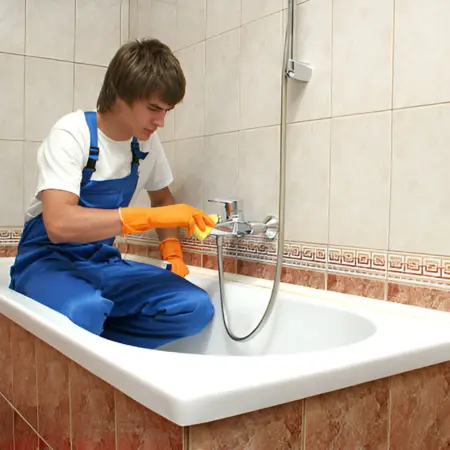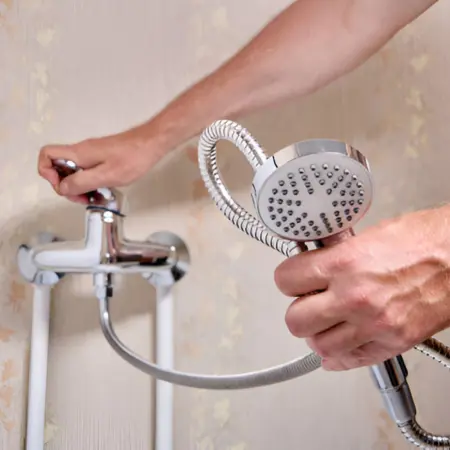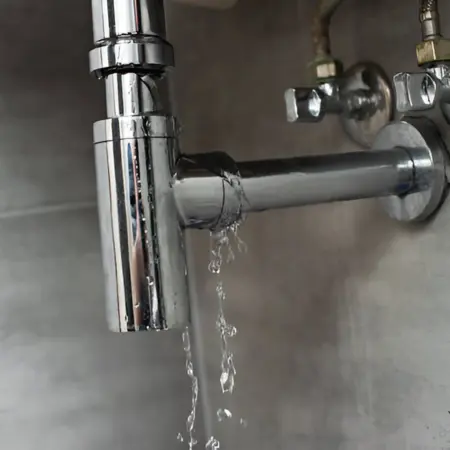Are you tired of spotting water puddles around your bathtub?
Bathtub leaks can be real, but understanding their common causes is the first step to fixing them.
Explore why your tub leaks and how you can easily repair it yourself.
Key Takeaways
- Constant exposure to water and steam can make caulk crack and grout break down over time.
- Faucet connections can loosen if they aren’t installed correctly.
- If water pools around the tub when it’s full, the overflow drain might be blocked or broken.
- Use waterproof tape or a patch kit to cover small cracks until you can fix them properly.
- A loose showerhead can cause water to spray in the wrong places.
- Use a utility knife or caulk remover to remove the old caulk or grout carefully.
- If you see major water damage and leaks keep happening, it’s time to ask for help.
Common Causes Of Bathtub Leaks
Bathtub leaks can be a real headache, but knowing their common causes can help you fix them quickly.
Here are some common causes that make your bathtub leaks:
1. Worn-Out Caulk (Seal) Or Grout (Glue)
Caulk is a rubbery material that seals gaps between the bathtub and the wall.
Grout fills the spaces between tiles.
Over time, constant exposure to water and steam can cause caulk to crack and grout to decay.
This can happen due to daily use, temperature changes, and even cleaning products.
Signs Of Wear
These are the signs of wear in caulk and grout:
- Cracking: Small cracks in the caulk or grout.
- Discoloration: The material may turn yellow, brown, and darken.
If you notice these signs, it’s time to replace the caulk or re-grout to prevent leaks.

2. Damaged Or Loose Faucet Connections
Faucet connections can become loose if they aren’t installed properly and if they’ve rusted over time.
Identifying Leaks From Faucets
Look for these signs:
- Dripping Water: Water drips from around the base of the faucet.
- Puddles: Any water pooling on the counter and floor near the faucet.
If you see any of these signs, you may need to tighten the connections or replace the faucet.
3. Cracked Or Damaged Bathtub
Bathtubs can have different types of cracks:
- Hairline Cracks: Very small and may not be easy to see.
- Structural Cracks: Bigger cracks that can weaken the tub.
Signs Of Damage
Here are two signs of a cracked bathtub:
- Discoloration: Dark spots and stains around the crack.
- Water Pooling: Puddles form under and around the tub when it’s filled.
If you find cracks, it’s important to repair them quickly to avoid further leaks.
4. Faulty Overflow Drain
This is a small drain located near the top of the bathtub.
It allows excess water to drain away, preventing the tub from overflowing.
When the water level gets too high, water flows into this drain instead of spilling over the sides.
If you see water pooling around the tub while it’s filled, the overflow drain might be blocked or damaged.
5. Broken Or Clogged Pipes
Pipes can get damaged for several reasons, such as:
- Tree Roots: Roots can grow into pipes, causing blockages.
- Age And Corrosion (Rust): Old pipes may rust or wear out over time.
Signs Of Pipe Leaks
Watch for these signs:
- Water Stains: Brown and yellow spots on walls and ceilings.
- Low Water Pressure: Water coming from taps might be weaker than usual.
If you suspect a problem, calling a plumber to investigate is a good idea.
6. Loose Or Damaged Showerhead
A loose showerhead can let water go where it shouldn’t.
If it’s cracked, water may spray out in all directions.

Signs Of A Problematic Showerhead
Here are the signs to look for:
- Dripping Water: Water dripping from the base of the showerhead.
- Uneven Spraying: Water spraying in strange directions or not coming out.
If you notice these issues, try tightening the showerhead or replacing it if it’s broken.
How To Repair Bathtub Leaks
Here are some easy steps to repair bathtub leaks:
1. Repairing Caulk Or Grout
Follow these steps to repair a clauk or grout:
Use a utility knife or a caulk remover tool to carefully remove the old caulk or grout.
Remove all the old material to create a clean surface.
Clean the area well with soap and water, and let it dry completely.
Use a caulking gun for the caulk to apply a smooth bead of new caulk along the gap.
Press it in evenly.
For grout, mix it according to the instructions, then use a grout float to press it into the spaces between tiles.
Smooth it with a damp sponge and let it dry as directed.
2. Fixing Faucet Connections
You’ll need these tools needed to fix the faucet connections:
- Adjustable wrench
- Screwdriver
- Plumber’s tape (optional)
Here’s how to fix it:
Turn off the water supply to the faucet.
Use a screwdriver to remove any covers or handles.
Then, use an adjustable wrench to tighten the connections.
Consider replacing them if they’re too rusty.
If you decide to replace it, take the old parts to the store to find the right size.
Wrap the plumber’s tape around the threads before putting new parts in to help seal them.
3. Repairing Cracked Bathtub
Here are temporary and permanent fixes:
- Temporary Fix: Use waterproof tape or a patch kit to cover small cracks until you can properly repair them.
- Permanent Fix: Use epoxy (glue) or a strong sealant (caulk) for bigger cracks.

4. Overflow Drain Repair
Check the overflow drain for any visible blockages and damage.
Remove the cover and clean any debris inside.
If the drain is damaged, you may need to replace it.
When To Call A Professional
If you can’t identify the issue or if the drain is hard to reach, it’s best to call a plumber.
Contact us at OP Plumbing Hub for pro services.
5. Addressing Pipe Issues
Here’s how to find pipe leaks:
- Look for water stains on walls, ceilings, and floors.
- Check for low water pressure when you turn on the taps.
Options For Repairing Or Replacing Damaged Pipes
- Repair: Use pipe sealant or epoxy for small leaks.
- Replace: For bigger issues, you may need to cut out the damaged section and replace it with a new pipe.
6. Fixing Showerhead Leaks
Here are steps to tighten or replace a leaking showerhead:
- Turn off the water supply.
- Use an adjustable wrench to tighten the showerhead carefully.
- If it leaks, unscrew the showerhead and check for worn-out washers and seals.
- Replace them if needed.
When To Call A Professional
It’s important to know when to call a professional.
If you notice serious water damage and leaks keep happening despite your efforts, it’s time to get help.
Plumbers can save you time and hassle because they have the right tools and skills.
They’ll ensure the repairs are done safely and correctly.
It will help to prevent more problems later.
Don’t hesitate to ask for help when things feel too complicated.
Conclusion
This article talks about common causes of bathtub leaks.
How to repair them has also been discussed. Contact us at OP Plumbing Hub for expert services.
